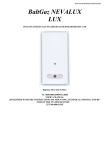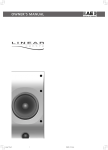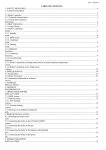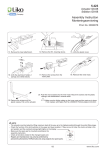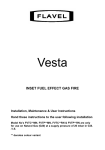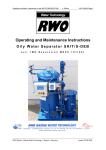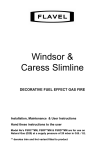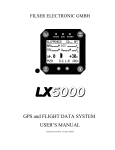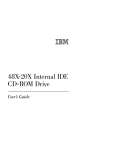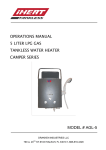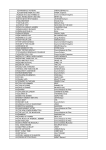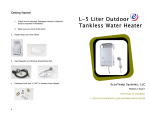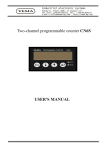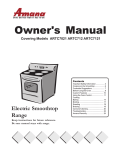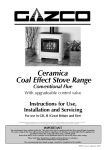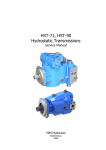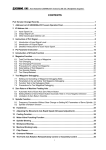Download User guide
Transcript
Dear Customer, Thank you for purchasing our gas water heater. At purchasing the appliance please check: - The scope of delivery; - Compatibility of pressure and the type of gas (natural or liquefied) used by you, with the pressure and type of gas indicated in the Acceptance certificate and with the table on the appliance. You should also require from the selling organization to fill in the warranty repair coupons. When purchasing the appliance against a credit, the payment schedule must be drawn up with indication of the full due and payable amount. The payment schedule must be signed by the Customer with the date indicated and with print full name. This manual contains information about the order of installation of the water heater, rules of its exploitation and technical service, following them will provide long-term, failure-free and safe operation of the appliance. Please read carefully this manual and follow the instructions in it. Best regards, Armavirsky Plant of Gas Equipment Ltd. The telephone number of the unified technical support Service is 8-800-555-40-35 (free call on the territory of Russian Federation, working hours of the service: twenty-four-hour) The installation of the appliance, the instruction of the owner about the appliance’s principles of operation and rules of its exploitation , technical service, failure correction and repair are effectuated only by a specialized service organization. Check and cleaning of the smoke exhauster, water supply pipelines system repair are effectuated by the housing operational services on the appliance’s owner’s request. The responsibility for safe exploitation of the appliance and its maintenance in appropriate condition is on its owner. Non-compliance with the safety measures and installation rules, rules of use and technical service, stated in this manual, can cause fire, burn, gas poisoning or poisoning with carbonic oxide (CO). Armavirskiy Plant of Gas Equipment Ltd. is constantly working on improvement of output products and reserves the right for insertion of necessary changes in the water heater’s construction. The following changes might not be displayed in the user’s manual. 30.05.2013 TABLE OF CONTENTS 1. SAFETY MEASURES INDICATION ................................................................................................................................ 3 2. DESCRIPTION AND OPERATION OF THE APPLIANCE ................................................................................................. 4 2.1. Purpose of the appliance .................................................................................................................................................................4 2.2. Technical characteristics .................................................................................................................................................................4 2.3. Supply package ...............................................................................................................................................................................5 2.4. Overall and connection dimensions of the appliance «BaltGaz NEVA-4511» .................................................................................6 3. USAGE OF THE APPLIANCE ............................................................................................................................................ 6 3.1. Putting the appliance «BaltGaz NEVA-4511» into operation ...........................................................................................................6 3.3. Temperature and water consumption regulation .............................................................................................................................6 3.4. Switching the appliance off ..............................................................................................................................................................7 3.5. Changing the batteries of the appliance «BaltGaz NEVA-4511» .....................................................................................................7 3.6. Protection from freezing ..................................................................................................................................................................8 3.7. Actions in emergency situations ......................................................................................................................................................8 4. APPLIANCE TREATMENT ................................................................................................................................................. 9 4.1. Examination .....................................................................................................................................................................................9 4.2. Treatment ........................................................................................................................................................................................9 5. TRANSPORTATION AND STORAGE RULES ................................................................................................................ 10 6. SAFETY MEASURES ....................................................................................................................................................... 10 7. INSTALLATION OF THE APPLIANCE ............................................................................................................................. 10 7.1.Place and scheme of installation ....................................................................................................................................................10 7.2. Mounting the appliance .................................................................................................................................................................11 7.3. Connecting the appliance to the DHW system ..............................................................................................................................12 7.4. Connecting the appliance to the gas system .................................................................................................................................12 7.5. Connecting the appliance to the balloon with liquefied gas ...........................................................................................................12 7.6. Hoses installation rules ..................................................................................................................................................................13 7.7. Connecting the appliance to the smoke exhauster ........................................................................................................................14 7.8. Battery installation into the appliance «BaltGaz NEVA-4511» .......................................................................................................15 7.9. Checking the appliance .................................................................................................................................................................15 7.10. Rendering the appliance to another type and pressure of gas ....................................................................................................15 8. CONSTRUCTION AND OPERATION CONTROL OF THE APPLIANCE ........................................................................ 15 8.1. Construction of the appliance «BaltGaz NEVA-4511»...................................................................................................................15 8.4. Operation of the appliance «BaltGaz NEVA-4511» .......................................................................................................................16 9. POSSIBLE FAILURES AND METHODS OF THEIR ELIMINATION ................................................................................ 19 10. GENERAL GUIDELINES ................................................................................................................................................ 20 11. HANDING THE APPLIANCE OVER TO THE CUSTOMER........................................................................................... 20 12. TECHNICAL SERVICE ................................................................................................................................................... 21 12.1. Examination .................................................................................................................................................................................21 12.2. Treatment ....................................................................................................................................................................................21 12.3. Technical service .........................................................................................................................................................................21 13. WORKS ORDER AT THE APPLIANCE’S REPAIR AND SPARE PARTS REPLACEMENT ........................................ 22 13.1. Casing removal............................................................................................................................................................................22 13.2. Burner replacement. ....................................................................................................................................................................22 13.3. Heat exchanger replacement......................................................................................................................................................22 13.4. Water and gas block replacement ...............................................................................................................................................23 13.5. Water block replacement .............................................................................................................................................................23 13.6. Replacement of cold water inlet pipe to the heat exchanger .......................................................................................................23 13.7. Replacement of the hot water output pipe from the heat exchanger ...........................................................................................23 13.8. Replacement of thermorelay (water overheating sensor) ............................................................................................................23 13.9. Replacement of thermorelay (draught sensor) ............................................................................................................................23 13.10. Replacement of the ignition plug or the flame sensor ................................................................................................................23 13.11. Replacement of water temperature sensor ................................................................................................................................23 13.12. Replacement of micro switch (water flow sensor) ......................................................................................................................24 13.13. Replacement of battery section .................................................................................................................................................24 13.14. Replacement of electromagnetic valve of the gas-tight shaft seal .............................................................................................24 13.15. Replacement of electronic control block ...................................................................................................................................24 ANNEX I. Separated spare parts scheme of the appliance .................................................................................................. 24 1. SAFETY MEASURES INDICATION 1.1. In order to avoid accidents and the appliance’s breakdown it is prohibited to: - Install and put the appliance into operation by yourself; - To switch the appliance on and regulate it in case if the person is not acquainted with this manual; - To close the grid or the spacing on the bottom part of the door or wall, which are designed for the inlet of air, necessary for gas burning, in the premise where the appliance is installed; - To use the appliance in case of no draught in the smoke exhauster; - To use the appliance violating the rules stated in this manual, and to use the appliance when it is out of service; - To disassemble and to repair the appliance by yourself; - To insert changes into the appliance’s construction; - To leave the appliance unattended when it is in operation; - To touch the casing next to the glory-hole and in close proximity to it, and also the combustion products outlet pipe next to the gas removal device of the appliance when the appliance is in operation, as the temperature of these surfaces might exceed 100 °С. 1.2. If water freezing in the water system of the appliance is possible, it is necessary to drain the water out of the appliance. 1.3. In case of detection of failure in the appliance’s operation it is necessary to address to a specialized service organization and not to use the appliance before the failure is eliminated. 1.4. In case of the appliance’s normal operation and in case if the gas pipeline is failure-free there must not be the smell of gas in the premise. IN CASE IF YOU FEEL THE SMELL OF GAS YOU MUST DO THE FOLLOWING: a) Close the gas inlet tap, located on the gas pipeline by the inlet into the appliance; b) Open the windows and doors in order to ventilate the premise, providing maximum fresh air inlet; c) Do not switch on or off the electric light or any other electronic appliances; d) Do not use open fire (lighter, matches etc.); e) Do not use the telephone in a gas-polluted premise; f) Do not smoke; g) Call the gas facility emergency operation service immediately. In case of non-fulfillment of the above-listed safety measures gas poisoning or poisoning with carbonic oxide (CO), contained in gas incomplete combustion products may occur. The first symptoms of poisoning are: heaviness in the head, strong palpitation, buzzing in the ears, swimming of the head, general weakness. Later nausea, vomiting, scant of breath and disordered motor functions may appear. The injured person may suddenly lose consciousness. In order to provide first aid it is necessary to: a) Bring the injured person outdoors into the fresh air; b) Unclasp clothes that constrain breath; c) Give household ammonia to smell; d) To cover warmly, but not letting to fall asleep and call the ambulance. I In case if there is no breath you must immediately bring the injured person to a warm premise with fresh air and make resuscitation, not stopping it before the doctor arrives. 2. DESCRIPTION AND OPERATION OF THE APPLIANCE 2.1. Purpose of the appliance 2.1.1. The instantaneous gas water heaters for domestic use «NEVA-4511», hereinafter referred to as “Appliances”, are produced according to the TU 4858-008-26985921-2008 (GOST R 51847-2009) standard and are designed for water heating for sanitary use (dish washing, laundry, taking a bath or shower) in the apartments or individual dwelling houses. 2.1.2. The appliances are designed for operation on natural gas according to GOST 5542-87 standard or liquefied gas according to GOST 20448-90 standards (the category of the appliances according to GOST R 51847-2009 – II2Н+3B/P). The appliance is output by the manufacturer company, being set up for a specific type of gas and gas pressure, indicated on a tablet on the appliance and in the Acceptance certificate. 2.1.3. The appliances are designed for connection to the smoke exhauster for combustion products removal out of the premise, they are equipped by the draught stabilizer and draught sensor, they have no ventilator in the combustion products removal duct and by the air inlet (type of the appliances according to GOST R 51847-2009 standard – В11BS). 2.2. Technical characteristics Table 1. Technical characteristics Parameters 2.2.1. Rated heating power, kWt 2.2.2. Rated heating effect, kWt 2.2.3. Performance index, %, not less than 2.2.4. Type of gas 2.2.5. Family; gas group 2.2.6. Rated gas pressure, kPa (mm w.g.): nd natural (G20, 2 family, group Н) rd liquefied (G30, 3 family, group В/Р) 2.2.7. Rated gas consumption: 3 natural, m /h liquefied, kg/h 2.2.8. Rated heating power of the ignition burner, kWt, not more than 2.2.9. Specific water consumption D (Т=30 С), l/min 2.2.10. Maximum water pressure, kPa 2.2.11. Minimal water consumption, l/min 2.2.12. Minimal water pressure, kPa 2.2.13. Water consumption at heating for Т=40 С, l/min 2.2.14. Water consumption at heating for Т=25 С, l/min 2.2.15. Required exhaustion in the smoke exhauster, Pa (mm w.g.), Not less than Not more than 2.2.16. Awerage combustion products temperature, С 2.2.17. Mass consumption of combustion products of natural/liquefied gas at rated heating power, g/s 2.2.18. Type of ignition of the appliance 2.2.19. Overall dimensions of the appliance, mm: height×width×depth 2.2.20. The appliance’s weight, NET / GROSS, kg, not more than 2.2.21. Main burner’s nozzles’ diameter, mm: Natural gas, 1,3 kPa (130 mm w.g.) Natural gas, 2,0 kPa (200 mm w.g.) Liquefied gas, 2,9 kPa (300 mm w.g.) 2.2.22. Ignition burner’s nozzles’ diameter, mm: Natural gas Liquefied gas 2.2.23. Type and voltage of batteries, V 2.2.24. Incessant operation duration with one set of batteries, h 2.2.25. Climatic category according to GOST 15150-69 standard «BaltGaz NEVA-4511» 21 18 84 Natural G20 / Liquefied G30 2nd; Н / 3rd; B/P 1,3 (130) 2,0 (200) 2,9 (300) 2,2 1,66 — 9,2* 1000 2,5 15 7* 11* 1,96 (0,2) 29,4 (3,0) 150 7,4 / 8,0 electronic 565×290×221 10,0/11,0 1,28 1,14 0,79 — LR20, 1,5 V 250* boreal climate 4.2 * The parameters are referential, for p.p. 2.2.9; 2.2.13; 2.2.14 – at water pressure not less than 250 kPa by the inlet into the appliance being in operation, for p.2.2.24 – at usage of alkaline batteries with increased energy output ratio. 2.3. Supply package Table 2. «BatGaz NEVA-4511» supply package Designation 3272-00.000 3251-00.000-01 RE 3272-10.000 3208-06.600 Name Water heater «BaltGaz NEVA-4511» User’s manual Package Mounting hardware set Spare parts 3103-00.014 Laying D19xd10x2 Note. The batteries are not included into the supply package. Quantity, pcs. 1 1 1 1 2 2.4. Overall and connection dimensions of the appliance «BaltGaz NEVA-4511» 1 – water consumption regulation knob; 2 – gas consumption regulation knob; 3 – water temperature display; 4 – casing; 5 – glory-hole; 6 – cold water inlet tap, screw thread G 1/2; 7 – gas inlet tap, screw thread G 1/2; 8 – hot water outlet tap, screw thread G 1/2; 9 – gas removal device hose; 10 – mounting holes. Scheme 2. Overall and connection dimensions of the appliance «BaltGaz NEVA-4511» 3. USAGE OF THE APPLIANCE For normal and safe operation of the appliance the conditions stated in the p.p. 2.2.10; 2.2.12 and 2.2.15 must be fulfilled (table 1). Non-fulfilment of these conditions may lead to abnormal or unstable operation of the appliance or its breakdown. The heating effect of the appliance indicated in p. 2.2.2 of the table 1 is provided (with accuracy ± 5%) in case of normal gas pressure at the inlet of the appliance being in operation, indicated in the Acceptance certificate 3.1. Putting the appliance «BaltGaz NEVA-4511» into operation 3.2.1. In order to put the appliance into operation it is necessary in the general case: a) To install the batteries into the battery section (see p. 7.8); b) c) d) e) To open the stop valve on the gas pipeline by the inlet into the appliance; To open the cold water stop valve by the inlet into the appliance; To turn the knobs 1 and 2 to the position of minimal water and gas consumption (scheme 5). To open the hot water tap, at this moment electric sparks must appear between the ignition plug and burner, (if the consumption of water going through the appliance would be not less than 2,5 l/min), from the electric sparks the burner must ignite and water heating must begin. ATTENTION! In order to avoid burns at putting the boiler into operation you should not approach your eyes too close to the glory-hole. Note. At the first ignition or after a long period of the apppliance’s idleness, the burner’s ignition will occur only after air removal from the gas pipelines. As electric sparks last approximately 7 seconds after turning the water on, it is necessary to close the hot water tap in order to prolongate the ignition, and then to open it again. This procedure must be repeated until the air is completely removed from the pipelines and until the burner’s ignition occurs. 3.2.2. After putting the appliance into operation it is necessary to visually check the burner’s operation (p. 4.1.3.). 3.3. Temperature and water consumption regulation 3.3.1. Water consumption regulation through the appliance is effectuated by the knob 1 (scheme 5): turning the knob towards the position “Minimal consumption” reduces water consumption, turning the knob towards the position “Maximum consumption” increases water consumption. Herewith at the knob position at “Minimal consumption” switching the water heater on occurs at water consumption not less than 2,5 l/min, at the knob position at “Maximum consumption” – at water consumption not less than 6 l/min. In the in-between positions of the knob 1 switching the water heater on occurs, respectively, in the consumption range not less than 2,5...6 l/min. At reduced inlet water pressure (at small water consumption provided by the water supply pipeline) for switching the appliance on it is recommended to leave the appliance’s knob 1 in the position “Minimal consumption”. In this position it is possible to receive small and middle hot water consumption (2,5...5 l/min) by the outlet from the appliance. In order to receive big amount of warm water by the appliance’s outlet at normal inlet water pressure (if consumption of 6 l/min and more is provided by the water supply pipeline) the knob 1 should be switched to the position “Maximum consumption”. а) Water consumption regulation knob 1 and gas consumption regulation knob 2 in the position “Minimal consumption” b) Water consumption regulation knob 1 and gas consumption regulation knob 2 in the position “Maximum consumption” Scheme 4. The appliance «BaltGaz NEVA-4511»’s regulation knobs’ position Note 1. At small consumption of water going through the appliance that is in operation, turning the knob 1 to the position “Maximum consumption” may lead to the burner’s flame failure. The burner’s flame failure is possible also in case of reducing the consumption by the hot water tap or at reduction of the inlet water pressure. In order to put the burner into operation again, it is necessary to turn the knob 1 to the position “Minimal Consumption” or to increase water consumption by the hot water tap. 3.3.2. Water temperature regulation through the appliance at its fixed consumption rate is effectuated by turning the gas consumption regulation knob 2 (scheme13,14): turning the knob into the position “Maximum consumption” increases gas consumption and water temperature at the appliance’s outlet, turning the knob to the position “Minimal consumption” reduces gas consumption and water temperature at the appliance’s outlet. It is also possible to regulate water temperature by the appliance’s outlet by changing water consumption with hot water tap or knob 1: water consumption increase leads to its temperature’s reduction, and on the contrary water consumption reduction leads to its temperature increase. Note 2. Water heating temperature is limited by the appliance’s heating effect: at big water consumption, especially in winter time, water at the appliance’s outlet may have unsufficient temperature even at maximum gas consumption. In this case in order to increase water temperature it is necessary to reduce the consumption of the water going through the water heater. Water temperature at the appliance’s outlet is shown on the two-digit digital display installed on the decorative trim on the appliance’s casing. Note 3. At small water consumption (with knob 1 in the position “Minimal consumption”) and big gas consumption (with knob 2 in the position “Maximum consumption”) water overheating in the heat exchanger is possible and consequently the burner might be switched off by the authomatic control system of the appliance. In order to switch the appliance on once again it is necessary to close the hot water tap and then to open it once again. In order not to let the water overheating occur it is necessary to reduce gas consumption with the knob 2 or to increase consumption of water going through the appliance with knob 1 or hot water tap. Water overheating in the heat exchanger leads to appearance of noise during the appliance’s operation and causes quick appearance of scale deposit in the pipes of the heat exchanger and narrowing of their clear opening what eventually leads to the appliance’s operation efficiency reduction and diminution of hot water current. So in order to reduce the temperature of water coming out of the appliance it is not recommended, especially in case of hard water, to use the mixer tap adding cold water, but it is recommended to use the above-listed methods.In order to reduce scale deposit appearance intensity it is recommended to prevent water heating at the appliance’s outlet for more than 60С. 3.4. Switching the appliance off After finishing the appliance’s usage (at nighttime, when not being at home etc.) it must be switched off. In order to switch the appliance off it is enough to stop water flowing through it by closing all hot water taps, after this it is necessary to make sure that the flame of the burner has completely gone out. ATTENTION! In case if after closing all hot water taps the main burner continues operating it is necessary to: Immediately shut the gas supply off with the gas stop valve installed by the inlet into the appliance. Then it is necessary to call the specialized service organization for the appliance’s repair. 3.5. Changing the batteries of the appliance «BaltGaz NEVA-4511» 3.5.1. At battery discharge it is necessary to install new batteries (2 pcs.) of dimension-type D into the battery section 14 (see scheme 14), in accordance with polarity, indicated on the internal side of the section’s coverplate. He indicator of battery discharge is the absence or a sustainable reduction of electric sparks between the ignition plug and burner after the beginning of water flow through the appliance (with consumption not less than 2,5 l/min). In order to open the battery section’s coverplate it is necessary to turn the coverplate’s knob into the position «ОN». In order to take the discharged elements out it is necessary to unbend the holddowns (shown with arrows on scheme 15). It is recommended to install alkaline batteries of the type LR20, of increased energy output ratio, providing longer operation time of the appliance. Installation of low quality batteries or of batteries with low energy output ratio will lead to their rapid discharge and loss of the appliance’s function. After installing the batteries it is necessary to close the section’s coverplate and turn the coverplate’s knob to the position «ОFF». 3.5.2. Battery replacement must be effectuated on the appliance when it is switched off. Scheme 6. Battery section 3.6. Protection from freezing In case if after switching the appliance off water freezing is possible in it, it is necessary to drain the water out of the appliance in the following way: а) Close the gas lock valve and cold water lock valve by the inlet into the appliance; b) Open the hot water tap; c)Switch the water consumption regulation knob to the position “Maximum consumption”, turn the plug 20 (scheme 12, 14), let the water drain to a tank and turn back the plug 20 up to the stop; d)close the hot water tap. 3.7. Actions in emergency situations In case of emergency situation during the appliance’s operation it is necessary to: a) Close the gas stop valve by the inlet into the appliance; b) Close the cold water stop valve by the inlet into the appliance (in case of water leakage appearance); c) Call the special service organization for the appliance’s repair. ATTENTION! At switching the appliance off by the draught sensor (thermorelay 16, scheme 12, 14) it is necessary to close the hot water tap and ventilate the premise. Switching the appliance on the next time would be possible after thermorelay’s self-cooling (in 1-2 minutes). In case of repeated shutdowns of the appliance by the draught sensor it is necessary to address to a specialized service organization in order to eliminate the failure of the gas outlet system. Switching the draught sensor off and incompetent handling of it is unacceptable and can cause poisoning with carbonic oxide. 4. APPLIANCE TREATMENT In order to provide long-term and failure-free operation of the appliance and keep its operating characteristics it is necessary to regularly effect its examination, treatment and technical service. In order to provide fire safety it is necessary to carefully control the burners’ cleanness and to prevent the appearance of smoky flame at gas burning, which leads to soot deposit on the heat exchanger. Herewith the spacings between the heat exhanger’s gills are covered with soot, in consequence of which the flame casts out of the combustion chamber, what may lead to fire. The examination and treatment are effectuated by the appliance’s owner. The appliance’s technical service is effectuated by a specialized service organization not later than in 12 months after the appliance’s installation and then not less than once in 12 months. ATTENTION! Works connected with technical service are not the manufacturer company’s warranty liabilities an are effectuated at the customer’s cost. 4.1. Examination 4.1.1. Every time before switching the appliance on it is necessary to: Make sure that there are no highly flammable objects next to the appliance; Make sure that there is no smell of gas in the premise, in case of gas smell detection call the gas facility emergency service. 4.1.2. After igniting the main burner it is necessary to visually check its operation: the flame must be blue, straight and without yellow smoky edges, indicating the burners’ sections’ inner channels dirtying. The burner’s sections’ inner channels dirtying causes incomplete gas combustion, which leads to following consequences: Appearance of carbonic oxide (sweetdamp) in big amounts, which may lead to poisoning; Appearance of soot in big amounts and its deposit on the heat exchanger, which worsens heat exchange and can lead to the appliance’s breakdown. 4.2. Treatment 4.2.1. The appliance must be kept clean, for this it is necessary to regularly remove dust from the appliance’s upper surface, and also to wipe the appliance’s casing first with a moist and then with a dry wiper. In case of sustainable dirtying, you should first wipe the casing with a wet wiper, moistened with a neutral detergent, and then with a dry wiper. 4.2.2. It is prohibited to use detergents of heightened effect and containing abrasive particles, gasoline and other organic solvents for cleaning the casing’s surface and plastic details. ATTENTION! All appliance treatment operations must be effectuated only after it is switched off and has cooled down. 5. TRANSPORTATION AND STORAGE RULES 5.1. The appliance must be stored and transported in the package only in the position indicated on the handling symbols. 5.2. The appliance must be stored in a closed premise that guarantees protection from atmosphere and other harmful impacts at air temperature from −50 ºС to +40 ºС and relative humidity not more than 98%. 5.3. In case of the appliance storage for more than 12 month it must be subject to conservation according to the GOST 9.014−78 standard. 5.4. Inlet and output tap orifices must be closed by cover plugs. 5.5. Every 6 months of storage the appliance must be subject to technical examination, under which the absence of ingress of moisture and dust stoppage of the appliance’s blocks and details is checked. 5.6. The appliances shold be laid in not more than eight tiers at stocking in stockpiles and transporting. 6. SAFETY MEASURES 6.1. Mounting of the appliance, its putting into operation and technical service must be effectuated only by a specialized service organization. The appliance’s mounting must be effectuated in accordance with the project, complying with the requirements of national and local regulatory acts, regulating the installation of gas appliances. 6.2. Placement of the appliance, pipelines, smoke exhausters, chimneys and other engineering equipment must provide safety of their exploitation, convenience of technical service and repair. 6.3. Before putting the appliance into operation it is necessary to effect the following: To check the compliance of the settings indicated in the section 15 (page 30) of this manual and in the tablet on the appliance, with gas type and pressure available at the place of the appliance’s installation. In case of noncompliance it is necessary to effect the appliance’s resetting to the used gas type and pressure in accordance with p. 7.10 (page 16); Make sure that the mounting was correct and the smoke exhauster is air-tight; In ordert to provide correct operation of the appliance and to keep warranty it is necessary to fulfill the requirements of this manual. 7. INSTALLATION OF THE APPLIANCE Installation of the appliance must be effectuated by a specialized service organization. After installing the appliance, checking of its working capacity and instructing the owner of the appliance by the employee of the organization that installed the appliance, there must be made a mark about the appliance’s installation in the warranty repair coupon. ATTENTION! Before installing the appliance it is necessary to check the compliance of the settings indicated in section 15 of this manual and in the tablet on the appliance with the gas type and pressure available at the place of the appliance’s installation. In case of non-compliance it is necessary to effect the appliance’s resetting to the used gas type and pressure in accordance with p. 7.10 . 7.1.Place and scheme of installation 7.1.1. The appliance must be installed in kitchens or in other non-residential heated premises in accordance with the gasification project and rules and regulations SP 62.13330.2011. 3 7.1.2. The volume of the premise where the water heater is installed must be not less than 8 m . 7.1.3. The premise where the water heater is installed must have good ventilation and constant inlet of fresh air (small window or an operable transom), as during the appliance’s operation oxygen burning occurs. Grids or a spacing at the bottom part of the door must not be closed tightly. 7.1.4. The appliance must be connected to the smoke exhauster with good draught (exhaustion 1,96…29,4 Pa) and also must be installed as close to the smoke exhauster as possible. One of possible ways to check the draught in the smoke exhauster is shown on scheme 7. No draught- (the candle Unsufficient draught Good draught (the candle flame flame does not bend)- do not use (the candle flame bends) – do is blown out) –the appliance can be used the appliance not use the appliance Scheme 7. The way to check the draught in the smoke exhauster 7.1.5. The appliance must be installed on fire resistant walls - brickbuilt, concrete (with ceramic plating or without it). 7.1.6.It is acceptable to install the appliance on slow burning walls in condition if the wall is isolated by a zinc-coated steel sheet 0,8…1 mm thick on a sheet of basalt felt woolen board 3…5 mm. The wall isolation must come out of the dimensions of the appliance’s casing not less than for 100 mm on every side (scheme 8). The distance from the side surfaces of the appliance to the slow burning walls with no usage of isolation must be not less than 250 mm. If this distance is reduced to 150 mm the installation of heat insulation is necessary (covering the walls with a zinc-coated steel sheet on a sheet of heat insulation material). When installing the appliance on fire resistant walls the isolation device is not required. 7.1.7. It is prohibited to install the appliance on wooden walls; plastered walls with a wooden base, on the walls covered with highly flammable materials. 7.1.8. It is prohibited to install the appliance above a heat source or open fire. Scheme 8. Installing the appliance on slow burning walls 7.1.9. The place and height of installation of the appliance must provide the fulfillment of the requirements stated in p. 7.7 of this manual. Herewith it is recommended to install the appliance on such height that the glory-hole would be at the customer’s eye level or as close to it as possible. Also in order to effect maintenance service at the appliance’s installation it is necessary to keep the following spacings: The distance from the side surface of the appliance to the side wall must be not less than 150 m; Free space by the inlet into the appliance’s front surface must be not less than 600 mm. 7.1.10. Scheme of the appliance’s installation (putting it into operation) is shown on scheme 9. It is recommended to connect the appliance at first to the water supply pipeline, to fill the appliance’s system with water and then connect it to the gas supply pipeline. Cold water inlet Water tap Gas outlet pipe Cold water stop valve Cold water inlet Gas pipeline stop Valve Gas inlet Shower device Water tap Cold water inlet Sink Cold water outlet Water filter Bath Scheme 9. The appliance’s installation scheme 7.2. Mounting the appliance 7.2.1. Before mounting the appliance it is recommended to remove the casing, for this it is necessary to do the following: а) To remove the knobs 1 and 2 (see scheme 1, 2), pulling them toward yourself; б) to screw out two casing fixation screws on the appliance’s bottom part (see scheme 12, 14); в) to disconnect the wires, connecting the display with the electronic control block and the water temperature sensor; г) to pull the casing’s bottom part towards yourself, move it upwards and remove from the appliance; If the appliance’s casing or rear wall is covered with a protective polythene film, the protective film must be removed before the appliance’s installation. Also it is necessary to remove stickers with warning or advertising information from the casing’s front surface (if there are any) ATTENTION! Do not let little children play with the packaging material, as it may be dangerous for them. After installing the appliance the package may be utilized. 7.2.2. The appliance is hanged by mounting holes (on the rear wall) on two hangers installed into the wall (hangers and wall dowels are included into the supply package). The position and size of the mounting holes, and also overall and connection dimensions for connecting water and gas pipelines and combustion products outlet are shown on scheme 1, 4. 7.3. Connecting the appliance to the DHW system 7.3.1. In order to increase the appliance’s working lifespan and improve its exploitation characteristics it is recommended to install the water filter before the appliance (see scheme 9). 7.3.2. In order to facilitate further technical service it is necessary to install a stop valve on the cold water supply pipeline by the inlet into the appliance (scheme 9). The stop valve must be easily accessible. 7.3.3. The connection of the appliance to the DHW system must be effectuated with metal pipes or flexible hoses with inner diameter not less than 13 mm. The water inlet and outlet flexible hose length must be not less than 2,5 m. The rules of flexible hoses installation are stated in p. 7.6. 7.3.4. The cold water supply connection must be effectuated to the cold water inlet tap 6, and hot water– to the hot water outlet tap 8 (see scheme 1, 2), previously taking off the protective cover plugs from the taps. 7.3.5. The connection of the cold and hot water pipelines must not be accompanied with mutual overpull of the pipes and parts of the appliance in order to avoid displacement or breakdown of some parts of the appliance and break of the water system’s airtightness. 7.3.6. Before connecting the water heater to the DHW system it is necessary to open the cold water supply for some time, in order to clean the pipe of water supply to the appliance and to prevent undesirable dirt and deposits inserton into the appliance at its initial run. 7.3.7. After connecting the pipelines to the appliance it is necessary to check the joints airtightness. Airtightness check is effectuated in the following order: а) open the hot water tap; b) open the cold water stop valve by the inlet into the appliance; c) after filling the appliance’s duct with water close the hot water tap and examine the joints. Leakage at the joints is unacceptable. It is recommended also to examine the appliance’s water duct joints, as break of their airtightness is possible in case of violation of the appliance’s transportation and storage conditions. If necessary the joints must be tightened up. Maximum water pressure for which the appliance is designed (also in case of water heat expansion) - 1000 kPa. 7.4. Connecting the appliance to the gas system 7.4.1.In order to provide the appliance’s stable operation it is necessary to effect the gas pipeline connection with metal pipes or flexible hoses with inner diameter not less than 13 m. The flexible hose for gas inlet, in accordance with the requirements of SP 62.13330.2011, must be resistant to the inlet gas at set pressure and temperature. The flexible hose length must be not more than 2,5 m. The flexible hoses installation rules are stated in p. 7.6. The pipes or the flexible hose are connected to the tap 7 (see scheme 1, 2) after removing the protective cover plug from it. 7.4.2. At gas pipelines installation the number of dismountable joints must be reduced to a minimum. 7.4.3. At gas pipelines connection to the appliance by the inlet into the appliance a stop valve must be necessarily installed. The stop valve must be easily accessible. 7.4.4. The connection of the gas pipe must not be accompanied with mutual overpull of the pipes and parts of the appliance in order to avoid displacement or breakdown of some parts of the appliance and break of the gas pipeline’s airtightness. 7.4.5. After connecting the appliance to the gas pipeline the joints of the appliance and pipeline must be checked for airtightness. Checking the gas supply joints’ airtightness is effectuated when the appliance is not in operation and the stop valve by the inlet into the appliance is in open position. Gas leakage is unacceptable. Checking of the joints’ airtightness is effectuated by means of a soap solution bubble test (or by other safe methods with no use of open fire sources). Bubble appearance means gas leakage. 7.5. Connecting the appliance to the balloon with liquefied gas 7.5.1. Before connecting the appliance to the the balloon with liquefied gas make sure that your appliance is set up for operation on this type of gas. Otherwise the appliance must be reset for it. (see p. 7.10). 7.5.2. The balloon with liquefied gas must be necessarily equipped with a reduction unit with vapor phase stabilization 3 pressure of 2,9 kPa and and vapor phase capacity not less than 1 m /h. ATTENTION! Using reduction units with stabilization pressure different from 2,9 kPa IS PROHIBITED. 7.5.3. The flexible hose length for connecting the appliance must be not more than 2,5 m., the inner diameter- not less than 12 mm. The gas supply flexible hose must be resistant to the supplied gas at set pressure and temperature. Rules of flexible hoses installation are stated in p. 7.6. 7.5.4. By the inlet into the inlet into the appliance a stop valve must be installed. The stop valve must be easily accessible. 7.5.5. After finishing the appliance’s mounting it is necessary to check the joints and the whole length of the connection hose in order to detect gas leakage (see p. 7.4.5). 7.5.6. In order to avoid accidents it is PROHIBITED: To keep gas balloons and lay hoses under direct sunlight, close to heat sources (heating stove, oven, heating radiators, other heating appliances); To heat the balloons by means of flame or heating appliances; To use damaged gas balloons. 7.5.7. It is recommended to keep gas balloons in a special metal cabinet in order to limit access of children and unauthorized persons to them. 7.6. Hoses installation rules 7.6.1. Hoses used for the appliance’s connection must be certified for conforming use. After their working lifespan’s termination the hoses must be necessarily replaced. 7.6.2. Connecting the appliance with the hoses the following installation rules must be fulfilled: Do not twist the hoses along their direct axis; Prevent the hose’s bend next to the tips: the length of the hose’s section length at the bonding, that must not be bended, must be not less than 50 mm; The hose’s bending radius, measured on the external generating line, must be not less than 90 mm. It is recommended to: Use angle joints and adapters in order to avoid the hoses’ bending next to the tips; Use intermediate bearers when installing long hoses; In case of linear position install the hoses with freespan. The recommended mounting schemes of the flexible hoses are represented in table 4. 7.6.3. The hose mounting must be started from the hose’s fixed elements, which have pipe cylindrical thread (if the mating part is fixed). 7.6.4. Tightening of the threaded joint of the tap with the mating part (radial connection) must be effectuated using belt teflon pipe tape or a sealing material, providing the threaded joint’s airtightness. 7.6.5. The threaded joinst of captive nuts (end joint), both adjustable and fixed, with mating tap must be effectuated using layings. The laying material is oil and petrol resistant rubber, asbestos-free paronite or polytetrafluorethylene (teflon). Table 4. Flexible hoses installation schemes Wrong Correct 7.7. Connecting the appliance to the smoke exhauster 7.7.1. In order to remove all gas combustion products and to provide safe operation of the appliance the following requirements to the smoke exhauster and gas fue pipe, connecting the appliance and the smoke exhauster, must be fulfilled:: The smoke exhauster must be air-tight and resistant to thermal load and combustion products impact. It is unacceptable to use ventilation channels for combustion products removal; The draught in the smoke exhauster must be in the range from 1,96 to 29,40 Pa (see table 1 and scheme 7); The gas flue pipe material must be corrosion-resistant, non flammable and endure long-term operation at the temperature up to 200 С (the recommended materials are: stainess, zinc plated or enameled steel, aluminum, copper with wall thickness not less than 0,5 mm); Gas flue pipe must have inner diameter not less than 110 mm; Gas flue pipe’s vertical section length from the appliance must be not less than 500 mm; Gas flue pipe’s length from the vertical section to the smoke exhauster must be not less than 2 m; Gas flue pipe must have a slope of not less than 2 upwards toards the place of joint with the smoke exhauster and a minimal number of turns (not more than three); Gas flue pipe and its connection with the appliance must be airtight, it is recommended to effect the connection of the pipe to the appliance in accordance with scheme 10. Variant 1 – gas flue pipe; 2 – hose of the gas removal device of the appliance 3 – thermoresistant sealer; 4 – thermoresistant aluminum tape. Scheme 10. Scheme of gas flue pipe connection 7.7.2. A variant of connecting the appliance to the smoke exhauster is shown on scheme 11. Correct Wrong The gas flue pipe’s end is too close to the opposite wall of the smoke exhauster. In the smoke exhauster there is a hole on the level of the place of connection of the gas flue pipe (also with another device connected to it). Two devices have the same connection to the smoke exhauster. Smoke exhauster Gas flue pipe Scheme 11. Connecting the appliance to the smoke exhauster 7.8. Battery installation into the appliance «BaltGaz NEVA-4511» Batteries of the dimension-type D (2 pcs. of 1,5 V voltage) are installed into the battery section 14 (see scheme 14) in accordance with polarity, indicated on the internal side of the section’s coverplate. In order to open the battery section’s coverplate it is necessary to turn the coverplate’s knob into the position «ОN». It is recommended to install alkaline batteries of the type LR20, of increased energy output ratio and providing longer operation time of the appliance. After installing the batteries it is necessary to close the section’s coverplate and turn the coverplate’s knob to the position «ОFF». 7.9. Checking the appliance 7.9.1. After installing the appliance and airtightness check the main burner’s operation (p. 4.1.3), safety authomatic system (p.8.4.6. for «BaltGaz NEVA-4511») and water heating temperature. Switching the appliance on and off and water temperature regulation must be effectuated in accordance with section 3. Checking the thermorelay’s (draught sensor’s) working capacity must be effectuated in accordance with p. 12.3.5. Note. After the appliance’s storage in a premise with subzero temperature its initial run must be effectuated not earlier than in 1,5 h after its transportation to a warm premise. 7.9.2. If necessary (in case of unsufficient water heating) gas pressure at the inlet into the appliance should be checked, for this it is necessary to: a) Close the gas inlet tap by the inlet into the appliance; b) To screw out the screw from the tap 21 (scheme 14) and connect a differential pressure gauge to the tap; c) Open the gas tap by the inlet into the appliance and check the differential pressure gauge’s connection for airtightness; d) Switch the appliance on and set the maximum heating power mode; e) Define the gas pressure according to the differential pressure gauge, that must correspond with the pressure indicated in the Acceptance certificate After making measurements it is necessary to: a) Switch the appliance off and close the gas tap by the inlet into the appliance; b) c) Switch the differential pressure gauge off and screw up the screw in the tap up to the stop; Open the gas tap by the inlet into the appliance and check the tap for airtightness. 7.10. Rendering the appliance to another type and pressure of gas 7.10.1. Resetting the appliance to another type and pressure of gas must be effectuated by a specialized service organization. For the appliance’s resetting it is necessary to use only the branded set of details. 7.10.2. In order to reset the appliance to another type and pressure of gas it is necessary to replace the nozzles of the main burner for the nozzles with orifice diameter in accordance with table 1 for the type and pressure of gas on which the appliance will work. Before effecting the resetting it is necessary to switch the appliance off and close the gas stop valve. 7.10.3. After the resetting it is necessary to check the joints airtightness (see p. 7.4.5). 7.10.4. Gas type and pressure, to which the appliance was reset , must be indicated in the Acceptance certificate ( indicating the organization that effectuated the resetting, and the date) and on the table on the appliance. 8. CONSTRUCTION AND OPERATION CONTROL OF THE APPLIANCE 8.1. Construction of the appliance «BaltGaz NEVA-4511» 8.3.1. The wall-hung appliance «BaltGaz NEVA-4511» (scheme 2) has a rectangular form, formed by the removable casing имеет 4. On the front side of the casing the following items are located: water consumption regulation knob 1, gas consumption regulation knob 2, water temperature display 3 и glory-hole 5 for watching the burner’s flame. All main elements of the appliance are mounted on the rear wall 22 (scheme5). 8.3.2. Purpose of the main blocks and spare parts of the appliance «BaltGaz NEVA-4511» (scheme 14): Water and gas block 4 is designed for regulating gas supply to the burner, regulating water and gas consumption and consists of water and gas blocks (the block’s construction provides gas supply to the burner only in case of water flow); burner 5 is designed for creating of air and gas mixture and its supply to the combustion place; gas removal device 9 is designed for combustion products outlet to the smoke exhauster; ignition plug 10 is designed for creating an electric spark for the burner’s ignition; flame sensor 11 provides the burner operation control; heat exchanger 12 provides transfer of the heat received at gas combustion to the water flowing in its pipes; thermorelay 16 (draught sensor) is designed for switching off the appliance in case of no draught in the smoke exhauster or if the exhaustion in it is less than 1,96 Pa. The tremorelay has normally-closed contacts with disjunction temperature 90 С; the water temperature sensor 18 is designed for defining water temperature at the outlet from the appliance; thermorelay 19 (water overheating sensor) is designed for switching the applianceа off at water heating for more than 90 °С; plug 20 is designed for water drain from the DHW circuit of the appliance in order to prevent its freezing; a safety valve inserted into the plug is designed for protection of DHW circuit of the appliance from increased water pres- sure. 8.4. Operation of the appliance «BaltGaz NEVA-4511» 8.4.1. The appliance’s flow chart is represented on scheme 15. 8.4.2. At the beginning of water flow through the water block 22 with water consumption not less than 2,5 l/min the gas valve 30 is opened by the membrane stem 25 and the contacts of the micro switch 17 close, after this the control block 15 starts feeding high-voltage current impulses to the ignition plug 10 and the electromagnetic valve 13 opens. Ignition of the burner 5 comes from electric sparks between the ignition plug’s electrode and the burner section nozzle. Then the burner’s operation is controlled by the flame sensor 11. 8.4.3. Water consumption regulator 1 regulates the volume and temperature of the water coming out of the appliance: turning the regulator counterclockwise increases water consumption and reduces its temperature; turning the regulator clockwise reduces water consumption and increases its temperature. The regulator’s position also defines water consumption with which switching the appliance on and off occurs (see p. 3.3.1). 8.4.4. Gas consumption regulator 2 regulates the volume of gas coming to the burner in order to receive required water temperature at its set consumption: turning the regulator counterclockwise increases gas consumption and water temperature; turning the regulator clockwise reduces gas consumption and water temperature. 8.4.5.At water flow stop or at its consumption reduction to a volume less than 2,5...6 l/min (depending of the water consumption regulator 1 position) the contacts of the micro switch 17 open and the valves 13 and 30 close. The burner’s flame goes out. 8.4.6. The appliance is equipped with safety devices, providing: gas access to the burner only in case of water flow; stop of gas supply to the burner in case if its flame goes out; switching the appliance off in case of no draught in the smoke exhauster; switching the appliance off in case of water heating for more than 90 °С; switching the appliance off in case of loss of electrical power. 1 – water consumption regulator; 2 – gas consumption regulator; 3 – tablet; 4 – water and gas block; 5 – burner; 6 – cold water inlet tap; 7 – gas inlet tap; 8 – hot water ourlet tap; 9 – gas removal device; 10 – ignition plug; 11 – flame sensor; 12 – heat exchanger; 13 – electromagnetic valve; 14 – battery section; 15 – electronic control block; 16 – thermorelay (draught sensor); 17 – micro switch (water flow sensor); 18 – water temperature sensor; 19 – thermorelay (water overheating sensor); 20 – water drain plug; 21 – gas pressure tap; 22 – rear wall; 23 – casing fixation screws. Scheme 14. Appearance of the appliance «BaltGaz NEVA-4511» without casing 1 – water consumption regulator ; 2 – gas consumption regulator; 3 – water temperature display; 4 – water and gas block; 5 – burner; 6 – cold water inlet; 7 – gas inlet; 8 – hot water outlet; 9 – gas removal device; 10 – ignition plug; 11 – flame sensor; 12 – heat exchanger; 13 – electromagnetic valve; 14 – battery section; 15 – electronic control block; 16 – thermorelay (draught sensor); 17 – micro switch; 18 – water temperature sensor; 19 – thermorelay (water overheating sensor); 20 – water drain plug; 21 – gas pressure tap; 22 – water block; 23 – water filter; 24 – water consumption restrictor; 25 – membrane; 26 – Venturi tap; 27 – water outlet to the heat exchanger; 28 – gas block; 29 – gas filter; 30 – gas valve; 31 – gas outlet to the burner. Scheme 15. Flow chart of the appliance «BaltGaz NEVA-4511» 9. POSSIBLE FAILURES AND METHODS OF THEIR ELIMINATION Table 6. Possible failures of «BaltGaz NEVA-4511» Failure Probable cause Methods of elimination When the hot water tap is The batteries are not installed into the battery Install or replace the batteries in acopened the appliance does not secton (or they are improperly installed) or switch, there is no electric spark. they are fully discharged. cordance with polarity. Unsufficient water consumption for switching Increase water consumption with hot wathe appliance on at the set position of the ter tap or move the knob knob 1 (scheme2). 1 to the position “Minimal consumption” (scheme 5). Unsufficient water consumption because of Open the stop valve by the appliance’s incomplete opening of the taps. inlet and the hot water tap completely. Unsufficient water consumption (less than 2,5 l/min while the taps are opened completely), caused by the following: Low water flow rate in the DHW pipeline Address the sanitary engineering service in order to eliminate the cause of low water flow rate. To effect installation of the pipelines in Violation of the requirements stated in this accordance with the requirements of this manual at pipelines installation manual.* . To clean or replace water filters.* To slean the heat exchanger from scale Water filter stoppage. deposit (see p. 12.3.2).* Scale deposit in the heat exchanger. Electrical open. Find and eliminate the electrical open.* The appliance does not switch on when the hot water tap is opened, there is an electric spark. Appearance of soot deposit on the ignition plug electrode. The electronic control block, the miscro switch or the water block membrane is out of service. The gas stop valve by the inlet into the appliance is closed. Presence of air in gas pipelines Effect the ignition plug electrode’s cleaning from soot deposit *. Replace the broken items.* Open the gas stop valve by the inlet into the appliance. See note p. 3.2. . The electromagnetic valve is out of service or Replace the electromagnetic valve or the contacts of its connection are disrupted. restore the contacts. * The electric spark does not get into the cur- Regulate the distance 5±0,5 mm between the ignition plug electrode’s end rent of air and gas mixture of the burner. and the burner’s nozzle.* The supply of liquefied gas in the balloon has Replace the balloon with liquefied gas expired. . Слабый искровой разряд. After После short-term operation the appliance is switched off. The batteries have discharged. The contacts of the battery section are oxygenized. Unsufficient draught (the appliance is switched off by the authomatic control system). The hot water temperature at the Appliance’s outlet is more than 90 °С (the appliance is switched off by the authomatic control system). The water block membrane is damaged The contact with the flame sensor is disrupted or the sensor’s electrode touches the burner’s details or is out of the flame zone (the burner operates during 7 seconds at continuing electric sparks and then switches off). Appearance of soot deposit on the flame sensor’s electrode. There are no temperature read- The water temperature display is not conings on the water temperature nected (the contacts are disrupted). display. The water temperature display is out of service. After switching the appliance on The water temperature sensor is not con- Replace the batteries . Clean the contacts of the battery section .* Effect the smoke exhauster cleaning. Make the gas flue pipe joints airtight.* Close the hot water tap and when switching the appliance on the next time ( in 1-2 minutes) reduce the hot water temperature, reducing gas consumption or increasing water consumption . Replace the water block membrane.* Restore the contact with the flame sensor, regulate the position of its electrode.* Effect the cleaning of the flame sensor’s electrode from soot deposit *. Connect the water temperature display (restore the contacts).* Effect the water temperature display’s replacement.* Connect the water temperature sensor Failure water temperature is shown on display for a short time, and then letters «ЕЕ» appear. Unsufficient water heating (the specified heating power is not provided). Probable cause nected (the contacts are disrupted). The water temperature sensor is out of service. Dust deposits in the burner’s channels, soot deposits on the heat exchanger’s gills or scale deposits in the heat exchanger’s pipeline. Low gas pressure. Methods of elimination (restore the contacts).* Effect the water temperature sensor’s replacement.* Effect the burner’s and heat exchanger’s cleaning .* Call the gas facilities service in order to eliminate the cause of it. Repair or replace the block that is out of Water or gas block is out of service. service .* The main burner’s flame is Dust deposit on the burner’s nozzles and Effect the burner’s cleaning.* weak, stretched, with smoky inner surfaces tongues. . During the appliance’s operation Big water consumption. Reduce the water consumption. increased noise of the flowing Layings slant in the water duct’s joints. Change layings *. water is detected. Water overheating in the heat exchanger. Reduce gas supply or increase water consumption. Close the gas stop valve by the inlet into The burner’s flame does not go Seizure of the water or gas block stem. the appliance and call the specialized out when the hot water tap is service organization for the appliance’s closed repair. . *The works are effectuated by a specialized service organization. 10. GENERAL GUIDELINES 10.1. The installation of gas appliances for domestic use must be effectuated in accordance with the project for the appliance installation and the rules and regulations SP 62.13330.2011. 10.2. It is necessary to install the appliance on fire resistant walls (brick-built, concrete, with ceramic plating) 10.3. The installation and technical service of the appliance must be effectuated only by a specialized service organization. The appliance must be connected only for the category of gas which is indicated in the user’s manual and the tablet on the appliance. 10.4. The installed appliance must necessarily be registede by the gas facilities service. 11. HANDING THE APPLIANCE OVER TO THE CUSTOMER 11.1. After installing the appliance the installer must check its operation in rated conditions. If necessary, respective regulations must be effectuated in order to reach the values indicated in the “User’s Manual”. 11.2. After finishing the installation and adjustment works the customer must be instructed about the order of use of the appliance: rules of water quantity regulation; rules of gas quantity regulation; order of switching the appliance on and off; Appliance treatment works, effectuated by the customer. The mark about the instruction must be made in the specific Certificate of the Installation of the appliance and effecting technical service. There should also be a mark about the appliance’s installation. 12. TECHNICAL SERVICE In order to provide long-term and failure-free operation of the appliance and to keep its operating characteristics it is necessary to regularly effect the examination, treatment and technical service. In order to provide fire safety it is necessary to be on the outlook for the burners’ cleanness, to prevent the appearance of smoky flame at gas combustion, which leads to soot deposit on the heat exchanger. In this case the spacings between the heat exchanger’s gills are covered with soot, in consequence to this the flame casts out of the combustion chamber, what may lead to fire. The examination and treatment are effectuated by the appliance’s owner. The appliance’s technical service is effectuated by a specialized service organization, not later than 12 months after the appliance’s installation and further not less frequently than once in 12 months. ATTENTION! The works connected with technical service are not the manufacturer company’s warranty liabilities and are effectuated at the customer’s cost. 12.1. Examination 12.1.1. Every time before putting the appliance into operation it is necessary to: Make sure that there are no highly flammable objects next to the appliance; Make sure that there is no smell of gas in the premise, in case of detecting the gas smell it is necessary to call the gas facilities emergency service. 12.1.2. After igniting the main burner it is necessary to visually check its operation: the flame must be blue, straight and have no yellow smoky edges which indicate the burners’ sections’ inner channels dirtying. The burner’s sections’ inner channels dirtying causes incomplete gas combustion, what leads to the following consequences: Appearance of carbonic oxide (sweetdamp) in big amounts, which may lead to poisoning; Appearance of soot in big amounts and its deposit on the heat exchanger, which worsens heat exchange and may lead to the appliance’s breakdown. 12.2. Treatment 12.2.1. The appliance must be kept clean, for this it is necessary to regularly remove dust from the appliance’s upper surface, and also to wipe the appliance’s casing first with a moist and then with a dry wiper. In case of sustainable dirtying, you should first wipe the casing with a wet wiper, moistened with a neutral detergent, and then with a dry wiper. 12.2.2. It is prohibited to use detergents of heightened effect and containing abrasive particles, gasoline and other organic solvents for cleaning the casing’s surface and plastic details. ATTENTION! All appliance treatment operations must be effectuated only after it is switched off and has cooled down. 12.3. Technical service At technical service following works are effectuated: Cleaning of the main and ignition burner; Cleaning of the heat exchanger from soot and cleaning (washing) the heat exchanger’s pipes from scale deposit (if necessary); Replacing the sealings in the gas and water systems; Checking the gas and water systems of the appliance for airtightness; Checking the thermorelay’s (draught sensor’s) operation Lubrication of flexible joints (if necessary); Unscheduled cleaning of the appliance (also from dust in the inner blocks and details). ATTENTION! It is necessary to effect the technical service operations connected with disassembling of its water or gas pipelines only after the appliance is completely switched off (the taps on the water and gas pipelines by the inlet into the appliance must be closed). 12.3.1. Cleaning the burners For cleaning the main burner it is necessary to effect the following operations: a) Switch the appliance off and close the gas stop valve; b) c) d) e) f) g) Remove the casing (see p. 7.2.1), remove the burner and disconnect the collector from it; Remove dust with a brush from the external surfaces of the burner and from the collector; Wipe the collector and nozzles with a moist wiper; Remove dust with a bottle brush from the burner’s section’s inner channels; Clean the electrodes of the ignition plug and flame sensor from soot deposit and clean up their contacts; To wash the burner with a soap solution, especially the internal cavities of its sections with the help of a bottle brush, wash it thoroughly with flowing water, dry and put it back. Keeping the burners clean will prevent the heat exchanger from soot dirtying and will prolong its working lifespan. 12.3.2. Cleaning the heat exchanger In case of the heat exchanger’s dirtying it is necessary to effect cleaning of its surfaces, on which soor deposit appeared, and of the heat exchanger’s pipes when scale deposit appears in them. In order to remove soot it is necessary to: a) Remove the heat exchanger and put into hot soap solution or a solution of another synthetic detergent; b) Hold it in the solution for 10-15 minutes and effect cleaning of dirty surfaces with the help of a soft brush, then wash it with a strong water stream; c) If necessary repeat the whole process. In order to remove scale deposit it is necessary to: a) Remove the heat exchanger and put it into a tank; b) c) prepare 10% citric acid solution (100 g citric acid powder for 1 litre warm water); pour the prepared solution into the heat exchanger’s pipeline and leave for 10-15 minutes, than pour the solution out and wash the pipeline thoroughly with water; d) If necessary repeat the whole process. 12.3.3. Sealings replacement At technical service, when disassembling and assembling of water and gas pipelines is effectuated, it is necessary to install new sealings. 12.3.4. Checking of the appliance’s gas and water systems airtightness After one of the regular technical services, when disassembling of water and gas pipelines was effectuated, it is necessary to check the appliance for airtightness (see p. 7.3.7 and 7.4.5). 12.3.5.Checking of thermorelay’s (draught sensor’s) working capacity In order to check the thermorelay it is necessary to disconnect the gas flue pipe from the appliance, switch the appliance on and close the appliance’s gas hose by a metal sheet at rated operating mode (with the completely opened gas tap and rated water consumption). The appliance must switch off in 10…60 seconds. In case if the thermorelay is out of service it is necessary to replace it, removing it from the gas removal device (scheme 12,14). For its replacement only a thermorelay provided by the manufacturer company may be used. After replacing the thermorelay it is necessary to repeat the test run. After checking the gas flue pipe must be connected to the appliance, providing the connection’s airtightness. 12.3.6. Unscheduled cleaning of the appliance It may be required to effect the appliance’s cleaning more frequently than once in 1 12 months, in case of intensive operation of the appliance in a premise where there is much dust in the air. This can be defined visually by the changed flame color of the ignition and main burners of the appliance. If the flame has become yellow or smoky, this indicates that the burner has been dirtied by the particles of dust from the air, and it is necessary to effect the cleaning and technical service of the appliance. At the burner’s normal operation the flame must be blue.. Unscheduled cleaning of the appliance must necessarily be effectuated also in case if in the premise where the appliance is installed, construction or reparation works were effectuated and much construction dust and waste got into the appliance. ATTENTION! In case of dust accumulation on the appliance’s inner blocks and details its inflammation is possible. 13. WORKS ORDER AT THE APPLIANCE’S REPAIR AND SPARE PARTS REPLACEMENT ATTENTION! The appliance’s repair operations, connected with disassembling of its gas or water pipelines, must necessarily be effectuated only after the appliance is completely switched off (the taps on the water and gas pipelines by the inlet into the appliance must be closed). When disassembling and assembling of the water and gas pipelines is effectuated, it is recommended to install new sealings. After replacing the blocks and details it is necessary to effect the assembling in the inverted sequence. Schemes of the appliances are represented on scheme 18 page 35 13.1. Casing removal. 13.1.1. Remove the knobs 10, pulling them toward yourself. 13.1.2. Disconnect the wires, connecting the display 12 with the electronic control block and water temperature sensor. 13.1.4. Screw out two self-threading screws, bonding the casing 11 with the carcass carrier 1, at the bottom part of the appliance. 13.1.5. Pull the bottom part of the casing 11 towards yourself, move it upwards and remove from the appliance. 13.2. Burner replacement. 13.2.1. Remove the casing, see p. 13.1. 13.2.2. Disconnect the wires from the ignition plug 18 and the flame sensor 19. 13.2.4. Screw out the captive nut of the burner collector 3. 13.2.5. Screw out two fixation screws of the burner 3 connecting it to the carcass carriers 1 and remove the burner. 13.2.6. Install the new burner. 13.2.7. Check for airtightness the joints, subject to disassembling, on the operating appliance by means of soap solution bubble test (see p. 7.3.7 and 7.4.5). 13.2.8. Check the new burner’s operation on the operating appliance. 13.3. Heat exchanger replacement 13.3.1. Effect the works listed in pp. 13.2.1-13.2.5 13.3.2. Screw out two self-threading screws connecting the plank 14 to the gas removal device and remove the plank. 13.3.3. Screw out two captive nuts from the heat exchanger’s taps 2 and remove it. 13.3.4. Install the new heat exchanger. 13.3.5. Check the joints subject to disassembling for airtightness on operating appliance by means of soap solution bubble test for gas and visual examination for water (see p. 7.3.7 и 7.4.5). 13.4. Water and gas block replacement 13.4.1. Remove the casing, see p.13.1. 13.4.2. Disconnect three wires from the electromagnetic valve 16. 13.4.3. Disconnect two wires from the micro switch 17 13.4.4. Disconnect the gas and water supply to the appliance. 13.4.5. Disconnect the adapter 15 from water and gas block 4. 13.4.6. Screw out four self-threading screws connecting the water and gas block 4 to the carcass carrier 1 and remove the water and gas block. 13.4.7. Install the new water and gas block. 13.4.8. After installing and connecting the water and gas block check the gas and water connections for airtightness. Water and gas leakages are unacceptable. 13.4.9. Check the appliance’s operation with the new water and gas block. 13.5. Water block replacement 13.5.1. Remove the casing, see p.13.1. 13.5.2. Disconnect water supply to the waer and gas block 4. 13.5.3. Disconnect the pipe nut 7 from water block 6. 13.5.4. Screw out two fixation screws connecting the water block 6 to the casing of the water and gas block. 13.5.5. Screw out two fixation screws connecting the water block 6 to the carcass carrier 1 and remove it. 13.5.6. Install the new water block. 13.5.7. Check the joints for airtightness. Water leakage is unacceptable. 13.5.8. Check the appliance’s operation with the new water block. 13.6. Replacement of cold water inlet pipe to the heat exchanger 13.6.1. Remove the casing, see p.13.1. 13.6.2. Screw off the captive nut of the pipe 7 from the water block tap 6. 13.6.3. Screw off the captive nut of the tap of the heat exchanger 2 and remove the pipe together with the layings 26 and 27. 13.6.4. Install the new pipe with new layings. 13.6.5. Check the appliance’s operation. Water leakage is unacceptable. 13.7. Replacement of the hot water output pipe from the heat exchanger 13.7.1. Remove the casing, see p. 13.1 13.7.2. Disconnect the wires and remove the thermorelay 22, screwing off the yoke screws 25. 13.7.3. Screw out the hot water temperature sensor 30 together with the ring 31. 13.7.4. Screw out two screws connecting the tap of the pipe 8 to the carcass carrier 1. 13.7.5. Screw off the nut of the pipe 8 from the tap of the pipe of the heat exchanger 2 and remove the pipe. 13.7.6. Install the new pipe. 13.7.7. Check the appliance’s operation. Water leakage is unacceptable. 13.8. Replacement of thermorelay (water overheating sensor) 13.8.1. Remove the casing, see p. 13.1 13.8.2. Disconnect two wires from the thermorelay 22 on the hot water outlet pipe 8. 13.8.3. Screw off two self-threading screws of the connection of the thermorelay with the yoke 25 and remove it. 13.8.4. Install the new thermorelay. 13.8.5. Check the appliance’s operation with the new thermorelay. 13.9. Replacement of thermorelay (draught sensor) 13.9.1. Remove the casing, see p. 13.1. 13.9.2. Disconnect the wires from the thermorelay 22. 13.9.3. Remove the carrier 23 from the thermorelay 22 from the gas cleaning plant, pushing up the coupling pawl on the carrier. 13.9.4. Screw off two self-threading screws connecting the thermorelay 22 to the carrier 23 and remove the thermorelay. 13.9.5. Install the new thermorelay. 13.9.6. Check the appliance’s operation with the new thermorelay. 13.10. Replacement of the ignition plug or the flame sensor 13.10.1. Remove the casing, see p. 13.1. 13.10.2. Disconnect the wires from the ignition plug 18 or from the flame sensor 19. 13.10.3. Screw off two self-threading screws connecting the plank 21 to the carrier 20, remove the ignition plug 18 or the flame sensor 19 13.10.4. Replace the ignition plug or the flame sensor. 13.10.5. Check the appliance’s operation with the new ignition plug or flame sensor. 13.11. Replacement of water temperature sensor 13.11.1. Remove the casing, see p. 13.1 13.11.2. Disconnect two wires from the temperature display 12. 13.11.3. Screw out the water temperature sensor 30 from the hot water outlet pipe tap 8. 13.11.4. Install the new sensor. 13.11.5. Check the appliance’s operation with the new sensor comparing the water temperature readings on the dis- play and the thremometer’s readings measuring the hot water temperature at the appliance’s outlet. 13.12. Replacement of micro switch (water flow sensor) 13.12.1. Remove the casing, see p.13.1. 13.12.2. Disconnect two wires from the micro switch 17. 13.12.3. Screw off two screws connecting the micro switch to the gas-tight shaft seal and remove it. 13.12.4. Install the new micro switch. 13.12.5. Check the appliance’s operation with the new micro switch. 13.13. Replacement of battery section 13.13.1. Remove the casing, see p. 13.1. 13.13.2. Disconnect two conductors from the battery section 33. 13.13.3. Open the coverplate of the battery section 33. 13.13.4. Screw off two self-threading screws connecting the battery section with the carrier and remove it. 13.13.5. Install the new battery section. 13.14. Replacement of electromagnetic valve of the gas-tight shaft seal 13.14.1. Remove the casing, see p.13.1. 13.14.2. Disconnect three wires from the electromagnetic valve 16 of the water and gas block 4. 13.14.3. Screw off two screws fixing the electromagnetic valve and remove it. 13.14.4. Install the new electromagnetic valve. 13.14.5. Check the appliance’s operation with the new electromagnetic valve. 13.15. Replacement of electronic control block 13.15.1. Remove the casing, see p.13.1. 13.15.2. Disconnect all external connecting wires and connectors of the electronic control block 32. 13.15.3. Screw off two self-threading screws connecting the electronic control block 32 to the carcass carrier 1 and remove it. 13.15.4. Install the new electronic control block. 13.15.5. Check the appliance’s operation with the new electronic block ANNEX I. Separated spare parts scheme of the appliance Scheme 17. Spare parts of the water and gas block 3251-02.400 Scheme 18. View of the appliance «BaltGaz NEVA-4511» with separated parts Pos. 1 2 3 4 5 6 7 8 9 10 Name Table 8. Spare parts catalogue of the appliance «BaltGaz NEVA-4511» Quan Designation tity Carcass Heat exchanger* Burner* (10 sections) nd Natural gas (G20, 2 family, group Н), 1,3 kPa nd Natural gas (G20, 2 family, group Н), 2,0 kPa rd Liquiefied gas (G30, 3 family, group В/Р), 2,9 kPa Water and gas block * Gas block * Water block * Pipe* (from the water block to the heat exchanger) Pipe* (hot water outlet) Trim* (with a protective film) light-grey Knob* (Ø 33 mm) light-grey 11 Casing* (white) or (white aluminum color) 12 Display * Nozzle* of the burner nd Natural gas (G20, 2 family, group Н), 1,3 kPa nd Natural gas (G20, 2 family, group Н), 2,0 kPa rd Liquiefied gas (G30, 3 family, group В/Р), 2,9 kPa Plank Adapter * Electromagnetic valve* Micro switch* (water flow sensor) Ignition plug * Flame sensor* Carrier Plank Thermorelay * 90 °С Carrier Wire * Yoke * Laying* (D19xd10x2) Laying *(D17xd10x2) Laying* (D28xd17x3) Ring *(d 15х2,65) Water temperature sensor * Ring * (d 6х1,8) Electronic control block* Battery section * 13 14 15 16 17 18 19 20 21 22 23 24 25 26 27 28 29 30 31 32 33 * Supplied as spare parts. 3272-01.000 3272-07.000 3272-02.100 3272-02.100-02 3272-02.100-01 3227-02.200 3227-02.310 3227-02.270 3272-04.000-01 3272-05-100-01 3272-00.050 3272-00.006 3272-03.000-03 или 3272-03.000-02 3227-07.003 3295.07.20.005-13 3295.07.20.005-10 3295.07.20.005-20 3272-00.004 3272-00.005 3227-02.290 3227-02.330 3227-02.130-01 3227-02.140-01 3272-02.001 3272-02.002 3222-15.000 3295.07.00.001 3222-14.000-01 3222-00.025 3103-00.014 3222-00.003 3219-00.07 3227-02.204-01 3227-12.000-01 3227-02.207-01 3272-16.000 3227-00.008 1 1 1 1 1 1 1 1 1 2 1 1 10 1 1 1 1 1 1 1 1 2 1 1 1 2 1 1 1 1 1 1 1


























